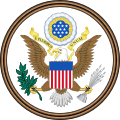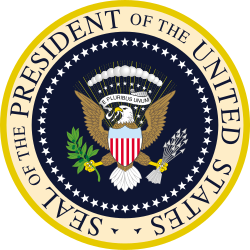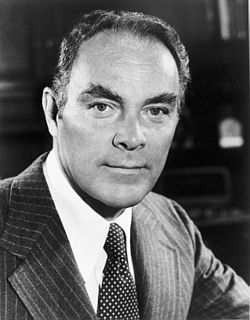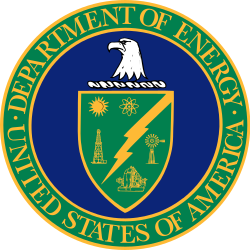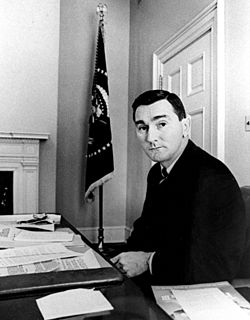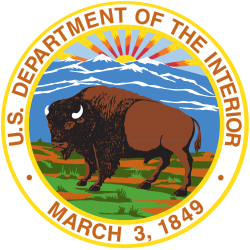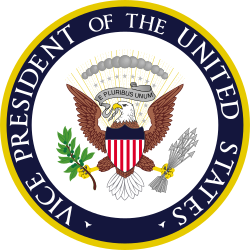Stabschef des Weißen Hauses
| Assistant to the President and Chief of Staff | |
|---|---|
 | |
 | |
| Susie Wiles Stabschefin des Weißen Hauses | |
| Stellvertreter | Principal Deputy Chief of Staff derzeit: - |
| Ernennung durch | Präsident der Vereinigten Staaten derzeit: Donald Trump |
| Schaffung des Amtes | 12. Dezember 1946 |
| Erster Amtsinhaber | John Steelman |
| Website | whitehouse.gov |
Der Stabschef des Weißen Hauses (englisch White House Chief of Staff; Abk. WHCS) ist der ranghöchste Mitarbeiter im Executive Office des Präsidenten der Vereinigten Staaten. Die volle Bezeichnung der Position lautet Assistant to the President and Chief of Staff (deutsch: Assistent des Präsidenten und Stabschef). Der Stabschef wird gelegentlich als „zweitmächtigster Mensch in Washington“ (nach dem Präsidenten) bezeichnet. Seit dem 20. Januar 2025 wird das Amt von Susie Wiles geführt.
Das Amt wurde 1946 unter der Bezeichnung Assistant to the President (deutsch: Assistent des Präsidenten) geschaffen. 1961 erhielt es seinen heutigen Namen. Der Amtsinhaber wird vom Präsidenten ernannt und ggf. auch entlassen. Dabei bedarf es nicht der Zustimmung des Kongresses.
Aufgaben und Geschichte
Vor 1946 gab es die Positionen des Sekretärs des Präsidenten (Secretary to the President) und des Appointments Secretary, die die Aufgaben einer Vielzahl von heutigen Mitarbeitern und Organen des Weißen Hauses übernahmen. Das Amt eines Assistenten des Präsidenten wurde während der Präsidentschaft von Harry S. Truman geschaffen, um der stark gewachsenen Exekutive Herr zu werden, und übernahm fast alle Aufgaben, die vorher dem Sekretär des Präsidenten zugeordnet waren. Mit dem Ende von Trumans Amtszeit als Präsident wurde auch die Position des Sekretärs des Präsidenten abgeschafft.
Amt und Titel des Stabschefs des Weißen Hauses im heutigen Sinne wurden von Präsident Dwight D. Eisenhower geschaffen, der aus seiner militärischen Karriere die Funktion eines Chefs des Stabes kannte und in seinem zivilen Amt in gleicher Weise einen „Gatekeeper“ zwischen sich selbst und Mitarbeitern bzw. Außenstehenden etablieren wollte. Als Neuling im politischen Leben entschied sich Eisenhower für Llewelyn Sherman Adams, der als langjähriger Gouverneur von New Hampshire jene Erfahrung einbrachte, die dem Präsidenten selbst fehlte.[1]
Die Aufgaben des Stabschefs hängen stark vom Präsidenten ab, allerdings ist er im Allgemeinen für die Verwaltung des restlichen Personals und des Kalenders des Präsidenten zuständig. Der Stabschef hat außerdem die Pflicht, den Zugang zum Präsidenten zu kontrollieren. Außerhalb der formellen Amtsbeziehung ist der Stabschef oft der wichtigste politische Berater des Präsidenten und häufig auch ein enger Freund.[2]
Einige Präsidenten, so John F. Kennedy, verzichteten auf die Einsetzung eines Stabschefs. Präsident Carter hatte erst am Ende seiner Amtszeit einen Stabschef. Alle Präsidenten außer Harry S. Truman und Lyndon B. Johnson hatten mehrere Stabschefs. Die durchschnittliche Amtszeit beläuft sich auf etwa zweieinhalb Jahre.
Die meisten Stabschefs waren vorher Politiker, und viele führen ihre politische Karriere später fort. Beispiele dafür sind die beiden Stabschefs unter Gerald Ford, Donald Rumsfeld und Dick Cheney, die später beide Verteidigungsminister wurden, letzterer sogar Vizepräsident. Richard Nixons Stabschef, der Offizier Alexander Haig, und Ronald Reagans Stabschef James Baker wurden beide später Außenminister.
Kritiker bemängeln, dass sich ein aktiver Stabschef unter einem eher passiven Präsidenten, der sich aus den Details der Regierungsarbeit heraushält, zu einem Quasi-Premierminister entwickeln kann. Während der Präsidentschaft Ronald Reagans übten James Baker und Donald Regan ihr Amt wie Quasi-Premierminister aus. Howard Baker, der Donald Regan als Stabschef folgte, stand solch einer Situation eher kritisch gegenüber.[3]
Im Vergleich dazu wurde Andrew Card, der Stabschef in der Bush-Regierung bis zum 14. April 2006, nicht als sehr machtvoll angesehen. Dies ist größtenteils darauf zurückzuführen, dass Bush lieber direkt mit seinen Ministern agierte. Ebenso waren Präsident Clintons Stabschefs aufgrund von Clintons Amtsführung, der immer den direkten Zugang zum Regierungsgeschehen suchte, im Allgemeinen relativ machtlos. Der Präsident mit den meisten Stabschefs war Barack Obama, welcher in seinen beiden Amtszeiten fünf Stabschefs berief.
Dem Stabschef stehen ein oder mehrere Stellvertreter zur Seite, die für verschiedene Aufgabenbereiche zuständig sind. Die Zuteilung unterscheidet sich in jeder Präsidentschaft. Unter Donald Trump gab es die Position des Hauptstellvertreters (Principal Deputy), der den anderen Stellvertretern vorgesetzt war.[4]
Liste der Stabschefs des Weißen Hauses
| Stabschef | Bild | Präsident | Amtszeit |
|---|---|---|---|
| John Roy Steelman |  | Harry S. Truman | 12. Dezember 1946 bis 20. Januar 1953 |
| Llewelyn Sherman Adams | 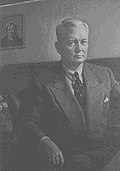 | Dwight D. Eisenhower | 20. Januar 1953 bis 7. Oktober 1958 |
| Wilton Burton Persons | 7. Oktober 1958 bis 20. Januar 1961 | ||
| de facto: Kenneth Patrick O’Donnell[A 1] |  | John F. Kennedy | 20. Januar 1961 bis 22. November 1963 |
| de facto: William Marvin Watson[A 1] |  | Lyndon B. Johnson | 1. Februar 1965 bis 26. April 1968 |
| de facto: James Robert Jones[A 1] |  | 26. April 1968 bis 20. Januar 1969 | |
| Harry Robbins Haldeman |  | Richard Nixon | 20. Januar 1969 bis 30. April 1973 |
| Alexander Meigs Haig Jr. |  | 4. Mai 1973 bis 21. September 1974 | |
| Donald Henry Rumsfeld |  | Gerald Ford | 21. September 1974 bis 20. November 1975 |
| Richard Bruce Cheney |  | 20. November 1975 bis 20. Januar 1977 | |
| William Hamilton McWhorter Jordan |  | Jimmy Carter | 18. Juli 1979 bis 11. Juni 1980 |
| Jack Hearn Watson Jr. |  | 11. Juni 1980 bis 20. Januar 1981 | |
| James Addison Baker III |  | Ronald Reagan | 20. Januar 1981 bis 4. Februar 1985 |
| Donald Thomas Regan |  | 4. Februar 1985 bis 27. Februar 1987 | |
| Howard Henry Baker Jr. |  | 27. Februar 1987 bis 1. Juli 1988 | |
| Kenneth M. Duberstein |  | 1. Juli 1988 20. Januar 1989 | |
| John Henry Sununu |  | George Bush | 20. Januar 1989 bis 16. Dezember 1991 |
| Samuel Knox Skinner |  | 16. Dezember 1991 bis 23. August 1992 | |
| James Addison Baker III |  | 23. August 1992 bis 20. Januar 1993 | |
| Thomas F. McLarty, III |  | Bill Clinton | 20. Januar 1993 bis 17. Juli 1994 |
| Leon Edward Panetta |  | 17. Juli 1994 bis 20. Januar 1997 | |
| Erskine Boyce Bowles |  | 20. Januar 1997 bis 20. Oktober 1998 | |
| John David Podesta Jr. |  | 20. Oktober 1998 bis 20. Januar 2001 | |
| Andrew Hill Card Jr. | 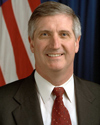 | George W. Bush | 20. Januar 2001 bis 14. April 2006 |
| Joshua Brewster Bolten |  | 14. April 2006 bis 20. Januar 2009 | |
| Rahm Israel Emanuel |  | Barack Obama | 20. Januar 2009 bis 1. Oktober 2010 |
| Peter Mikami Rouse (geschäftsführend) |  | 1. Oktober 2010 bis 13. Januar 2011 | |
| William Michael Daley | 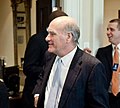 | 13. Januar 2011 bis 27. Januar 2012 | |
| Jacob Joseph Lew |  | 27. Januar 2012 bis 20. Januar 2013 | |
| Denis Richard McDonough |  | 20. Januar 2013 bis 20. Januar 2017 | |
| Reinhold Richard Priebus |  | Donald Trump | 20. Januar 2017 bis 31. Juli 2017 |
| John Francis Kelly |  | 31. Juli 2017 bis 2. Januar 2019 | |
| John Michael Mulvaney (geschäftsführend) |  | 2. Januar 2019 bis 31. März 2020 | |
| Mark Randall Meadows[5] |  | 31. März 2020 bis 20. Januar 2021 | |
| Ronald Alan Klain[6] |  | Joe Biden | 20. Januar 2021 bis 8. Februar 2023 |
| Jeffrey Dunston Zients |  | 8. Februar 2023 bis 20. Januar 2025 | |
| Susie Wiles |  | Donald Trump | seit 20. Januar 2025 |
Literatur
- Chris Whipple: The Gatekeepers. How the White House Chiefs of Staff define every Presidency. Broadway Books, New York 2018, ISBN 978-0-8041-3826-0.
- Michael Nelson: The Presidency and the Political System. Sage, 10. Auflage 2014. ISBN 978-1-4522-4043-5.
- Bradley H. Patterson: The White House Staff: Inside the West Wing and Beyond. Brookings Institution Press, 2004.
- Terry Sullivan (Hrsg.): The Nerve Center: Lessons in Governing from the White House Chiefs of Staff. Texas A & M University Press, College Station 2004, ISBN 1-58544-349-2.
Weblinks
Einzelnachweise
- ↑ Chris Whipple: The Gatekeepers. How the White House Chiefs of Staff define every Presidency. Broadway Books, New York 2018, ISBN 978-0-8041-3826-0, S. 18f.
- ↑ John P. Burke: Administration of the White House. In: Miller Center of Public Affairs. University of Virginia, archiviert vom am 17. November 2010; abgerufen am 15. März 2020 (englisch).
- ↑ Vgl. dazu David B. Cohen: From the Fabulous Baker Boys to the Master of Disaster: The White House Chief of Staff in the Reagan and G. H. W. Bush Administrations. In: Presidential Studies Quarterly. Vol. 32, No. 3, September 2002, ISSN 0360-4918 S. 463–483.
- ↑ Nancy Cook, Adam Cancryn: ‘Acting’ in name only: Mulvaney staffs up West Wing. In: Politico. Politico LLC, 11. Januar 2019, abgerufen am 15. März 2020 (englisch).
- ↑ Majid Sattar: Trumps Stabschef Meadows: Im engsten Machtzirkel. In: faz.net. Frankfurter Allgemeine Zeitung, 8. März 2020, abgerufen am 16. März 2020.
- ↑ Jeff Zeleny and Dan Merica CNN: Biden names Ron Klain as his White House chief of staff. Abgerufen am 12. November 2020.
- ↑ a b c Kenneth O’Donnell, W. Marvin Watson und James Robert Jones wurden nicht zum Stabschef ernannt, sondern füllten diese Funktion als Appointments Secretary aus.
Auf dieser Seite verwendete Medien
W. Marvin Watson chef de cabinet de la Maison Blanche
This photograph depicts Chief of Staff Dick Cheney during a meeting following the assassinations of Ambassador Francis E. Meloy, Jr. and Economic Counselor Robert O. Waring in Beirut, Lebanon.
Secretary of Defense Donald Rumsfeld in the Gerald R. Ford administration.
Portrait of Chief of Staff Alexander M. Haig, Jr.
Seal of the United States Department of Homeland Security. A graphically styled American eagle appears in a circular blue field. The eagle's outstretched wings break through an inner red ring into an outer white ring that contains a circular placement of the words "U.S. DEPARTMENT OF" in the top half and "HOMELAND SECURITY" in the bottom half. The outer white ring has a silvery gray border. As in The Great Seal, the eagle’s left claw holds an olive branch with 13 leaves and 13 seeds while the right claw grasps 13 arrows. Centered on the eagle's breast is a shield divided into three sections containing elements that represent the homeland "from sea to shining sea." The top element, a dark blue sky, contains 22 stars representing the original 22 agencies and bureaus that have come together to form the department. The left shield element contains white mountains behind a green plain underneath a light blue sky. The right shield element contains four wave shapes representing the oceans, lakes and waterways alternating light and dark blue separated by white lines.
Seal of the United States Department of Housing and Urban Development.
The seal was originally unveiled on November 10, 1966, and later defined in law (Federal Register 32FR366-67 and 24 CFR subtitle A, §11.1, both since removed as part of a streamlining of the federal code). The seal was defined as:
On a white background within a circle composed of the words, "U.S. Department of Housing and Urban Development," is an eagle and two stars. The six upper bars depicting the upper portion of the eagle's wings, the torso of the eagle, the star at the right of the eagle, and the words, "U.S. Department of Housing and Urban Development," are colored blue. The eight lower bars depicting the lower portion of the eagle's wings and the star at the left of the eagle are colored green."
The seal is a representative of high rise buildings simulating an eagle and giving emphasis to the "urban" in HUD's name. The eagle (shown abstractly) is a symbol of Federal authority. The use of green symbolizes open space, land, growth and prosperity. The blue in the Seal alludes to the quality of life and environment in America's cities.
More information here.The seal of the United States Department of the Treasury.
The original seal dates from the Board of Treasury during the Articles of Confederation, and so predates the department (and Federal Government) itself. The current design is a slight simplification of the original, introduced in 1968.
The seal's arms depicts balancing scales (to represent justice), a key (the emblem of official authority) and a chevron with thirteen stars (to represent the original states).
For more information, see here.Seal of the United States Department of Justice.
The origins of the seal are unknown; it was first used in the 19th century as the seal for the Office of the Attorney General (prior to the formation of the Department of Justice) but the exact date is unknown. Even the translation of the Latin motto is murky, a matter of debate between Latin scholars. The Department's currently accepted translation is who prosecutes on behalf of Lady Justice, referring to the Attorney General. The motto is an allusion to the wording of the writ in a qui tam action: qui tam pro domino rege quam pro se ipso sequitur ("he who sues on behalf of our lord the King as well as for himself." The current-day seal dates from 1934, when some (though not all) of the heraldic mistakes on the original were corrected. More information here.The seal of the United States Department of Health and Human Services. The symbol represents the American People sheltered in the wing of the American Eagle, suggesting the Department’s concern and responsibility for the welfare of the people. The colors are reflex blue and gold.
This seal is now just used for mainly legal purposes; the department has a separate logo which is used for its visual identity.
More information here and here.Seal of the United States Department of Education.
The seal was introduced on May 7, 1980, and is described in law as:More information here and 34 CFR Part 3.Standing upon a mound, an oak tree with black trunk and limbs and green foliage in front of a gold rising sun, issuing gold rays on a light blue disc, enclosed by a dark blue border with gold edges bearing the inscription "DEPARTMENT OF EDUCATION" above a star at either side of the words "UNITED STATES OF AMERICA" in smaller letters in the base; letters and stars in white.
Seal of the US Environmental Protection Agency (EPA).
Logo of the United States White House, especially in conjunction with offices like the Chief of Staff and Press Secretary.
White House Chief of Staff Wikipedia:John R. Steelman in 1950. In the original photo are, along with Steelman, Special Counsel Charles Murphy, President Harry Truman, and Admiral Robert Dennison.
Seal of the United States Department of Transportation, introduced on 17 November 1980. The seal is described in 49 CFR 3.1 as 'A white abstract triskelion figure signifying motion appears within a circular blue field. The figure is symmetrical. The three branches of the figure curve outward in a counter-clockwise direction, each tapering almost to a point at the edge of the field. Surrounding the blue circle is a circular ring of letters. The upper half of the ring shows the words “Department of Transportation”. The lower half of the ring shows the words “United States of America”. The letters may be shown in either black or medium gray. The official seal of the Department is modified when embossed. It appears below in black and white.'
Autor/Urheber: John Mathew Smith & www.celebrity-photos.com from Laurel Maryland, USA, Lizenz: CC BY-SA 2.0
Wash D.C. 1999
Official portrait of United States Secretary of the Treasury Jack Lew
Kenneth M. Duberstein (born April 21, 1944) served as U.S. President Ronald Reagan's White House Chief of Staff from 1988 to 1989.
WASHINGTON - Secretary of State Rex Tillerson and Secretary of Homeland Security John Kelly speak with Mexico’s Foreign Secretary Luis Videgaray and Secretary of Government Miguel Angel Osorio Chong before the U.S. Secretaries co-hosted a high-level dialogue with their Mexican counterparts on strategies to combat transnational criminal organizations at the U.S. Department of State in Washington, D.C., May 18, 2017. Official DHS photo by Jetta Disco.
James A. Baker III, U.S. Secretary of State, January 25, 1989 to August 23, 1992
Autor/Urheber: Michael Vadon - image has been cropped from original, Lizenz: CC BY 2.0
White House Chief of Staff Reince Priebus at CPAC 2017 February 23rd 2017
Jeff Zients walking with U.S. President Joe Biden in 2022.
Kenneth P. O'Donnell, Special Assistant to the President
Seal of the United States Department of the Interior.
The seal consists of a male bison with the head and body in a left position, standing on a prairie, with mountains and a rising sun in the background, enclosed within two concentric circles, having the words "U.S. Department of the Interior" and the date "March 3, 1849" (when Congress created the department) inscribed in the top and bottom arcs within these circles. See here for more information.
The bison seal dates from 1917, when it was used as the emblem on the initial department flag and thereafter replaced the old version of the seal, which used a federal eagle. The eagle was reinstated for a few years in the 1920s, and a different seal was used from 1968-69, but on both occasions the bison seal was reinstated. For more information see this chapter in The Department of Everything Else: Highlights of Interior History.White House Photo, Erskine Bowles, US Govt.
The creation of the new Department of Veterans Affairs in 1989 required a new official seal to represent VA. In November 1988, after the law establishing VA as a cabinet department was signed, VA initiated a competition among employees for a seal design that would give the new department a "new look." The winner of that competition, and creator of today's VA seal was David E. Gregory, a medical media production specialist at the Indianapolis VA Medical Center. These are the key elements of the seal, as he described them:
- The eagle represents the United States.
- The circle of five stars above the eagle represents the Army, Navy, Air Force, Marines and Coast Guard.
- The two flags in the eagle's talons represent the span of America's history from 13 colonies to the present 50 states.
- The flags are bound by a golden cord symbolic of those Americans who have fallen in service to their country.
- The eagle holds the cord to perpetuate the memory of those veterans who have fallen and sacrificed for the nation.
Portraits of Assistants to The Presidents Ed Meese James Baker Michael Deaver William Clark James Brady Richard Darman Ken Duberstein Fred Fielding Craig Fuller David Gergen John Herrington Ed Hickey James Jenkins Michael Mcmanus John Rogers Edward Rollins Larry Speakes John Svahn Lee Verstandig Faith Whittlesey, 9/19/1983
Autor/Urheber: Gage Skidmore from Peoria, AZ, United States of America, Lizenz: CC BY-SA 2.0
U.S. Congressman Mark Meadows speaking with attendees at the 2019 Teen Student Action Summit hosted by Turning Point USA at the Marriott Marquis in Washington, D.C.
Please attribute to Gage Skidmore if used elsewhere.Herbert E. Abrams Porträt von Donald Regan in seinem Büro im Weißen Haus 1986.
US Senator Howard Baker in 1989.
Seal of the Vice President of the United States. The blazon is defined in Executive Order 11884 as:
The design is the same as the Seal of the President of the United States, except that there is no ring of stars, the clouds are gray (instead of proper), the stars are gray (instead of argent), the scroll is gray (instead of white), the arrows are gray (instead of proper), and the background colors and inscription (obviously) differ.The Coat of Arms of the Vice President of the United States shall be of the following design:
SHIELD: Paleways of thirteen pieces argent and gules, a chief azure; upon the breast of an American eagle displayed holding in his dexter talon an olive branch proper and in his sinister a bundle of thirteen arrows gray, and in his beak a gray scroll inscribed "E PLURIBUS UNUM" sable.
CREST: Behind and above the eagle a radiating glory or, on which appears an arc of thirteen cloud puffs gray, and a constellation of thirteen mullets gray.
The Seal of the Vice President of the United States shall consist of the Coat of Arms encircled by the words "Vice President of the United States."
Congressman Rahm Emanuel (center) with Sol Schatz of the VFW, Thomas Lonze of the State of Illinois, James O’Rourke of the American Legion and Senator Dick Durbin (right) discussing the Welcome Home GI Bill.
Seal of the United States Department of Commerce.
The seal was approved on April 4, 1913 and is derived from the seal of the defunct United States Department of Commerce and Labor. It is composed of the arms (Per fesse azure and or, a ship in full sail on waves of the sea, in chief proper; and in base a lighthouse illumined proper), and crest ("The American Eagle displayed"). Around the arms, between two concentric circles, are the words "Department of Commerce" and "United States of America".
The official symbolism has been modified as the functions of the department have changed. As of 2007: the ship is a symbol of commerce; the blue denotes uprightness and constancy; the lighthouse is a well-known symbol representing guidance from the darkness which is translated to commercial enlightenment; and the gold denotes purity. The crest is the American bald eagle denoting the national scope of the Department's activities.
Full description at CFR Title 15 Part 1- Scope and content: Pictured: H.R. Haldeman, Assistant to the President. Subject: Staff Portraits II.
Bill Daley
White House acting Chief of Staff Mick Mulvaney speaks with reporters Thursday, Oct. 17, 2019, in the James S. Brady Press Briefing Room at the White House. (Official White House Photo by Joyce N. Boghosian)
Chief of Staff Denis McDonough in the Oval Office, April 1, 2015
Seal of the United States Department of Agriculture.
The USDA seal was created in 1895. It was adapted for use as a general identifier in 1980, but those usages were replaced with the USDA Logo in 1996. The seal has been withdrawn from use as a departmental identifier, though it is still used on legal materials and other internal uses.
The seal is defined as:Two and three-eights inches in diameter (azure), a shock of corn (or), upon a base (vert) an American plough proper. All within a double annulet (argent), outer roped, inner beaded, charged with the inscription: UNITED STATES DEPARTMENT OF AGRICULTURE, and at the base, a scroll bearing the legend: "1862.AGRICULTURE IS THE FOUNDATION OF MANUFACTURE AND COMMERCE. 1889." (or). A diapered background of 44 stars (argent) for the States of the Union.
The dates on the scroll represent the year the Department was founded by act of Congress (1862), and the year the Department was made an Executive Office headed by a Secretary of cabinet rank (1889). The 44 stars represent the states in the Union in 1889.
See here and here for more information.Seal of the United States Department of Defense from 2001 to 2022.
Seal of the United States Office of Management and Budget. It is described in Executive Order 11600 as:
On a blue disc, the Arms of the United States proper above a curved gold scroll inscribed "OFFICE OF MANAGEMENT AND BUDGET", in black raised letters, all within a white border edged gold and inscribed "EXECUTIVE OFFICE OF THE PRESIDENT OF THE UNITED STATES", in blue raised letters. Dark blue suggested by the Seal of the President denotes the direct organizational link with the Presidential office. The arms of the United States refer to the entire Nation and represent the Office's involvement in the organizational and technological processes necessary to assist the President in his role as Chief Executive of the United States.
Pete Rouse, American political consultant
White House Photo, US Government.
